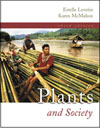
Plant Physiology |  |
Chapter Summary1. Plants obtain water from the soil, moving it up within the xylem through the entire plant. This movement of water is a passive phenomenon dependent on the pull of transpiration and the cohesion of water molecules. Minerals are also obtained from the soil and transported in the xylem. The translocation of sugars occurs in the phloem, moving from source (photosynthetic leaves or storage organs) to sink (growing organs or developing storage tissue) through mass flow within sieve tube members.
2. Sucrose is the usual sugar transported in the phloem; however, very few plants actually store this economically valuable carbohydrate. Sugarcane and sugar beet are the major sucrose-supplying crops. The early development of sugarcane plantations in North America greatly influenced the course of history by introducing the slave trade to the continent.
3. Plants are dynamic metabolic systems with hundreds of reactions occurring each second to enable plants to live, grow, and respond to their environment. All life processes are driven by energy, with some metabolic reactions being endergonic and others exergonic. Energy transformations occur constantly in biological systems and are part of the underlying principles of both photosynthesis and cellular respiration.
4. Photosynthesis takes place in chloroplasts of green plants and algae and results in the conversion of radiant energy into chemical energy (linking the energy of the sun with life on Earth). Using the raw materials carbon dioxide and water, along with chlorophyll and sunlight, plants are able to manufacture sugars. In the light reactions of photosynthesis, energy from the sun is harnessed, forming molecules of ATP and NADPH. During this process, water molecules are split, releasing oxygen to the atmosphere as a by-product. During the Calvin Cycle, carbon dioxide molecules are fixed and reduced to form sugars, using the energy provided by the ATP and NADPH from the light reactions.
5. Cellular respiration is the means by which stored energy is made available for the energy requirements of the cell. Through respiration, the energy of carbohydrates is transferred to ATP molecules, which are then available for the energy needs of the cell. During aerobic respiration, each molecule of glucose is completely oxidized during the many reactions of glycolysis, the Krebs Cycle, and the Electron Transport System, resulting in the formation of 36 ATP molecules. In anaerobic respiration, only two molecules of ATP are formed from each glucose molecule.
|
|
|